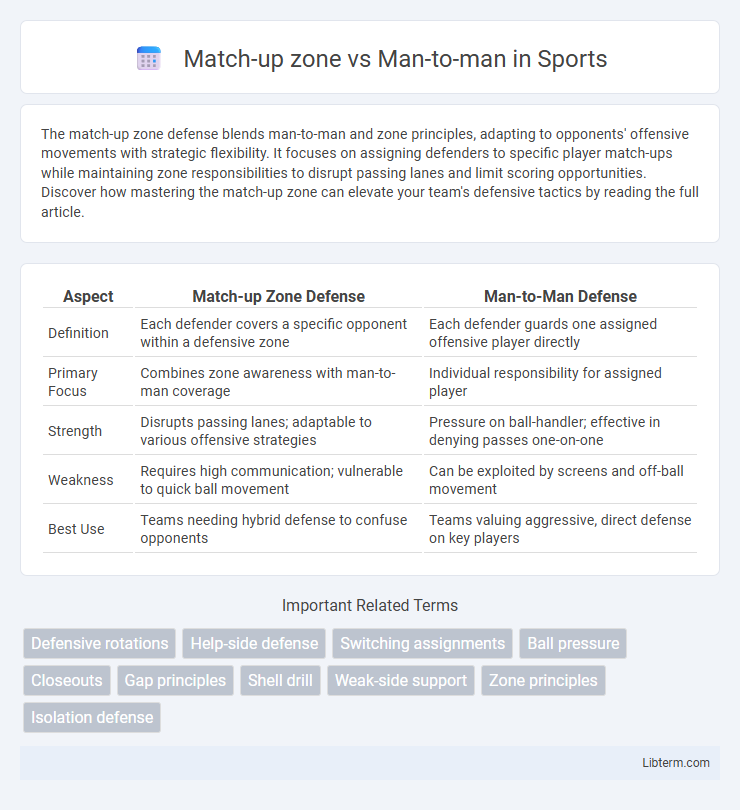The match-up zone defense blends man-to-man and zone principles, adapting to opponents' offensive movements with strategic flexibility. It focuses on assigning defenders to specific player match-ups while maintaining zone responsibilities to disrupt passing lanes and limit scoring opportunities. Discover how mastering the match-up zone can elevate your team's defensive tactics by reading the full article.
Table of Comparison
| Aspect | Match-up Zone Defense | Man-to-Man Defense |
|---|---|---|
| Definition | Each defender covers a specific opponent within a defensive zone | Each defender guards one assigned offensive player directly |
| Primary Focus | Combines zone awareness with man-to-man coverage | Individual responsibility for assigned player |
| Strength | Disrupts passing lanes; adaptable to various offensive strategies | Pressure on ball-handler; effective in denying passes one-on-one |
| Weakness | Requires high communication; vulnerable to quick ball movement | Can be exploited by screens and off-ball movement |
| Best Use | Teams needing hybrid defense to confuse opponents | Teams valuing aggressive, direct defense on key players |
Introduction to Match-Up Zone and Man-to-Man Defense
Match-up zone defense combines the principles of zone coverage with man-to-man responsibilities, where players guard specific areas but switch to man defense when opponents enter their zone. Man-to-man defense requires defenders to closely follow and contest individual offensive players throughout the game. Both strategies offer distinct advantages, with match-up zone blending flexibility and coverage, while man-to-man emphasizes pressure and individual accountability.
Key Principles of Match-Up Zone Defense
Match-up zone defense combines man-to-man principles with zone concepts, emphasizing active communication and seamless switching to maintain defensive balance. Key principles include maintaining proper spacing, anticipating offensive movements, and applying pressure selectively to disrupt passing lanes and prevent easy penetration. This approach requires defenders to identify threats quickly while supporting teammates, ensuring adaptability against various offensive setups.
Core Concepts of Man-to-Man Defense
Man-to-man defense is a basketball strategy where each defender is assigned to guard a specific offensive player, emphasizing individual accountability and close physical pressure. Core concepts include maintaining a stance that allows quick lateral movement, staying between the opponent and the basket, and anticipating the ball handler's actions to disrupt passing lanes. This defense relies heavily on communication, help-side positioning, and defensive rotations to counter offensive screens and cuts effectively.
Strengths of Match-Up Zone Defense
Match-up zone defense combines the advantages of man-to-man and traditional zone by allowing defenders to guard specific opponents within designated areas, increasing flexibility and adaptability. It excels in disrupting offensive sets through unpredictable coverage, leading to more forced turnovers and contested shots. This defense also conserves player energy by reducing constant on-ball pressure, enhancing team stamina during high-intensity games.
Advantages of Man-to-Man Defense
Man-to-man defense offers enhanced individual accountability by assigning each defender a specific opponent, promoting tighter coverage and reducing gaps on the court. This defensive strategy enables greater flexibility in reacting to offensive movements and helps disrupt passing lanes through aggressive, direct pressure. Teams employing man-to-man defense often experience improved communication and coordination, fostering better team synergy and defensive intensity.
Weaknesses of Match-Up Zone Defense
Match-up zone defense often struggles with communication breakdowns, leading to open gaps that skilled offenses exploit for high-percentage shots. Its complex coverage responsibilities can cause mismatches when players are forced to guard unfamiliar opponents, reducing overall defensive effectiveness. The scheme also tends to be vulnerable against strong outside shooting teams, as it can leave shooters with too much space beyond the arc.
Limitations of Man-to-Man Defense
Man-to-man defense often struggles against proficient pick-and-roll offenses, where defenders can be easily screened or confused, creating open scoring opportunities. This defense requires intense individual effort and stamina, leading to potential fatigue and breakdowns in communication over extended periods. It can also be exploited by mismatches when faster or stronger offensive players isolate slower defenders.
Tactical Differences: Match-Up Zone vs Man-to-Man
Match-up zone defense blends individual man-to-man principles with zonal coverage, assigning defenders to guard specific offensive players within defined areas to disrupt passing lanes while maintaining overall spatial control. Man-to-man defense requires each defender to closely follow a designated opponent throughout the court, prioritizing pressure and direct contesting of shots. Tactical differences include the match-up zone's emphasis on team coordination and spatial awareness versus the man-to-man's focus on individual defensive skills and constant opponent tracking.
Choosing the Right Defense: Situational Analysis
Match-up zone defense blends man-to-man principles with zone coverage, ideal for guarding versatile offenses and disrupting passing lanes, while man-to-man defense demands individual accountability and excels against teams with standout scorers. Teams facing quick perimeter shooters often prefer man-to-man to apply pressure directly, whereas match-up zone suits squads aiming to minimize mismatches and protect the paint. Choosing the right defense depends on opponent tendencies, player strengths, and game tempo to optimize defensive efficiency and limit high-percentage shots.
Conclusion: Which Defense Fits Your Team?
Match-up zone defense offers flexibility by combining zone principles with man-to-man assignments, making it ideal for teams with versatile defenders who can switch effectively and communicate well on the court. Man-to-man defense emphasizes individual accountability and is best suited for teams with strong, quick defenders capable of handling one-on-one pressure and maintaining tight coverage. Choosing the right defense depends on your team's personnel strengths, communication skills, and your coach's strategic preference for aggression or containment.
Match-up zone Infographic

 libterm.com
libterm.com